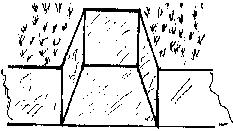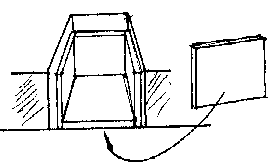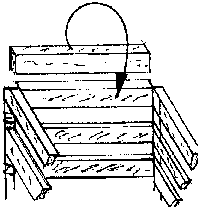 This is an article written and submitted to us by author and survival expert Ted Wright, author of Wright's Complete Disaster Survival Manual: How to Prepare for Earthquakes, Floods, Tornadoes & Other Natural Disasters, available at Amazon.com.
This is an article written and submitted to us by author and survival expert Ted Wright, author of Wright's Complete Disaster Survival Manual: How to Prepare for Earthquakes, Floods, Tornadoes & Other Natural Disasters, available at Amazon.com.
TheEpicenter.com has formatted the information below and has made only minor changes to the content for eye appeal purposes. These changes have been made with the submitter's approval.
The Pallet Root Cellar
Years ago when I began my odyssey as a "Domestic Survival Specialist" I began compiling the educational materials I felt were necessary for the layman to fully grasp the scope of "Successful Survival." In routine fashion, I searched my own memory banks recalling the many systems and hard lessons that I learned by trial and error during my time both in the London bomb shelter and as a Special Forces combat soldier. This led to what I considered was a complete educational package of survival material covering all aspects of survival needs.
High on the list, of course, was "Food & Water." Following a life long practice, my research led me to the study of the successful in this field; those who had conquered the very challenges facing today's post disaster survivor. I was led to the Native Americans and the early Pioneers who overcame the very problems we face today; storage and lack of refrigeration, both of which limit our efforts when it comes to food inventories.
Since 1980, when I started teaching others, the priorities have changed. Oh, we still need to put away supplies of food, but the urgency is now more focused on the amount required due to circumstances other than natural disaster. Since we live as we do (under the computer processed bottom line), happily on the trail of increased profits, the inventory of "ready-to-eat/ready to sell" food in the pipeline has been reduced to the barest minimum possible. As a result, grocery stores no longer have a stockpile of goods in the "back room." We notice that every few days the supermarket is stacked up and down the aisles with boxes of goods waiting to be stocked directly onto the shelves. Given this information, the fact that we must all face is that throughout the whole country there is less than a few days food supply readily available. If the truck does not roll on time, we are plumb out of luck!
Back in the 80's, I developed my "Pallet Root Cellar" to face the existing problems. This is obviously patterned after the old, rural storage system some of us still remember seeing way back when. The root cellar system allows for the storage of a great amount of food (and some beer, inside joke!) in a small space that is naturally regulated at a constant temperature of about 63 degrees year round. The only proviso is that the lid must be kept on at all times. Back in the old days it was a door.
All food stored in the root cellar should be of the dry variety, tightly sealed in dry containers. Rice, grains of all kinds, beans of all varieties, as well as packaged food items such as soups and similar items. The product of our food dehydrator is also stored down there. A typical meal example could be to select some beef stew base packets, boil some white beans, put in some dried carrots, tomatoes, and potatoes and with sourdough rolls enjoy a fine "backyard stew!"
Construction of the Pallet Root Cellar is very simple and can be made and put into use in a weekend. Here's how:
- Collect six pallets from outside stores and garbage pick up points or the local furniture movers.
- Measure your pallets (usually 4'x4') and dig a hole several inches bigger all round than the pallets. Be sure to allow enough depth for the top pallet to be below ground by 6" when it is put on.
Now you are ready to stock the box with food. I use 30 gallon plastic trash bins as containers and fill these first. Once food is placed in the storage unit, the top pallet should be put on. Pull the rolled plastic over the top to keep the inside cool.
You may decide to put hinges on the "lid," as well as make shelves or other improvements to my basic design.
As soon as the unit is full, cover the lid with a good 3" of newspaper, pull the plastic liner back in place and cover with a good strong plastic tarp. Then put rocks, bricks, or soil over the tarp to keep it in place.
That's it. You are now the proud owner of your own "Root Cellar" full of food. If you are careful in packing the items, you should have many months of food down there. This item is good for most natural disasters (except, obviously, floods) and as can be readily appreciated. Even if the house is flat, your food is still there waiting to be used. I am sure many of you have already envisioned many "Root cellars" all over the yard, some with food, some water, or clothes or?
Good luck! And, as always, please Think Survival!
-- Ted Wright
Some background about the author of this article: Ted Wright is a pioneer in the field of Disaster Survival. With voluminous hours of wartime search and rescue (London, WWII), numerous personal survival challenges (Special Forces Combat, etc.), and a wealth of practical experience, Ted brings home the message that anyone who is properly prepared can successfully survive a natural or man-made disaster. He covers a variety of topics from backyard survival to the necessary elements of a home medicine chest.
As Hurricane Opal bore down on the Gulf Coast, the People's Radio Network called on Ted for on-the-air direction and commentary to guide unprepared evacuees to safety with last-minute preparation tips. He broadcast live for an hour with only three minutes notice.
Ted will go anywhere, anytime to give his domestic survival message. He has never charged for his time; all he asks is that his expenses be paid and his needs be met.
Kacey Sack-Wright has been Ted's faithful partner in domestic survival since 1989. As a Special Educator who works with children with special needs, she has the patience to act as loving wife, and compassionate editor.
Affiliate Disclosure Statement: Some of the links on this page are affiliate links, which means that we may earn a commission or compensation if you click on the link or make a purchase using the link. When you make a purchase, the price you pay will be the same whether you use the affiliate link or go directly to the website using a non-affiliate link. By using our affiliate links, you are helping our website, and we genuinely appreciate your support!
Epicenter Supplies LLC is a participant in affiliate programs. When you click on any affiliate link or ad on our site, and are taken to a third party website, please check that site’s privacy policy if you want to learn how your personal information is used by that site.






